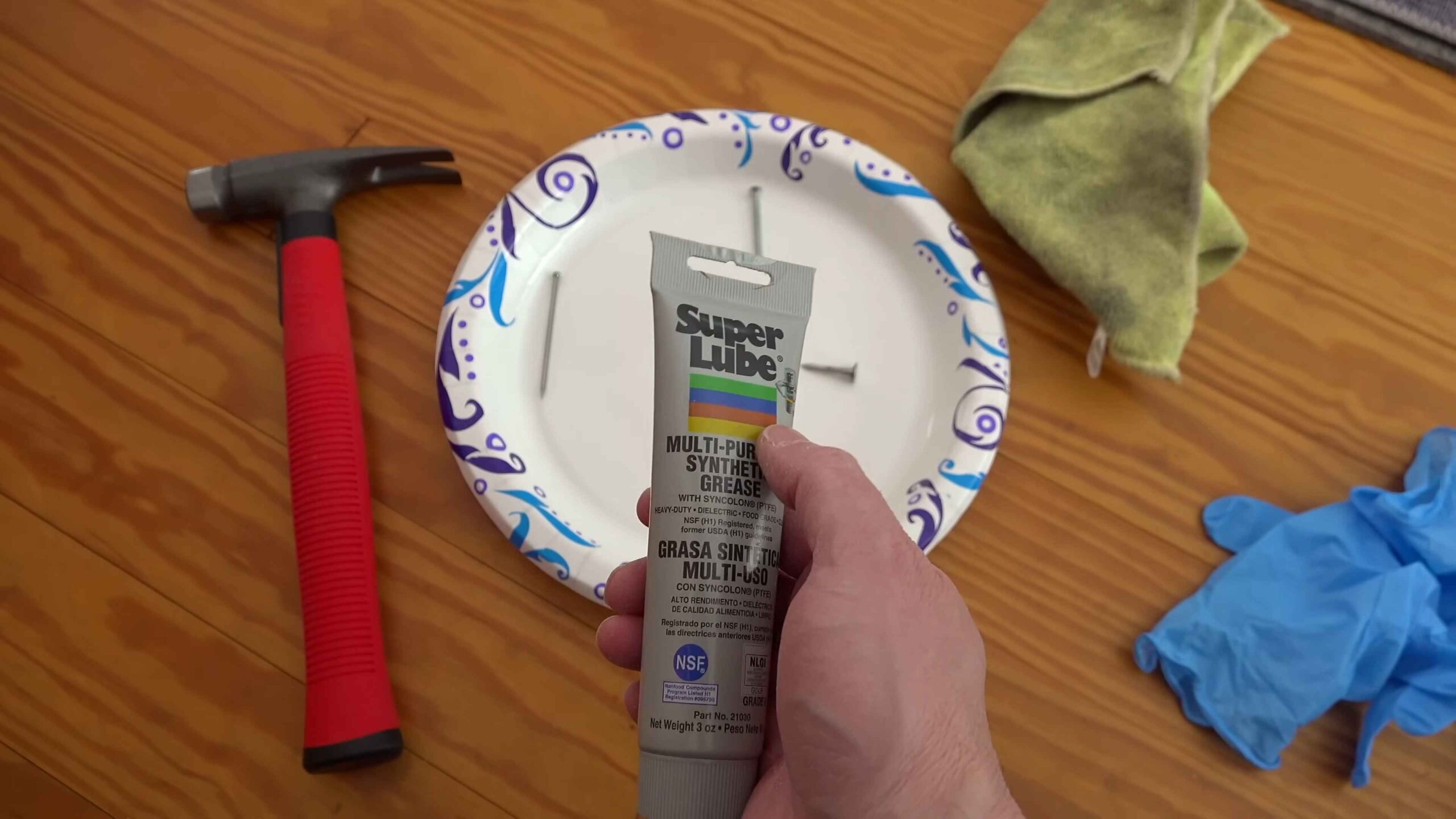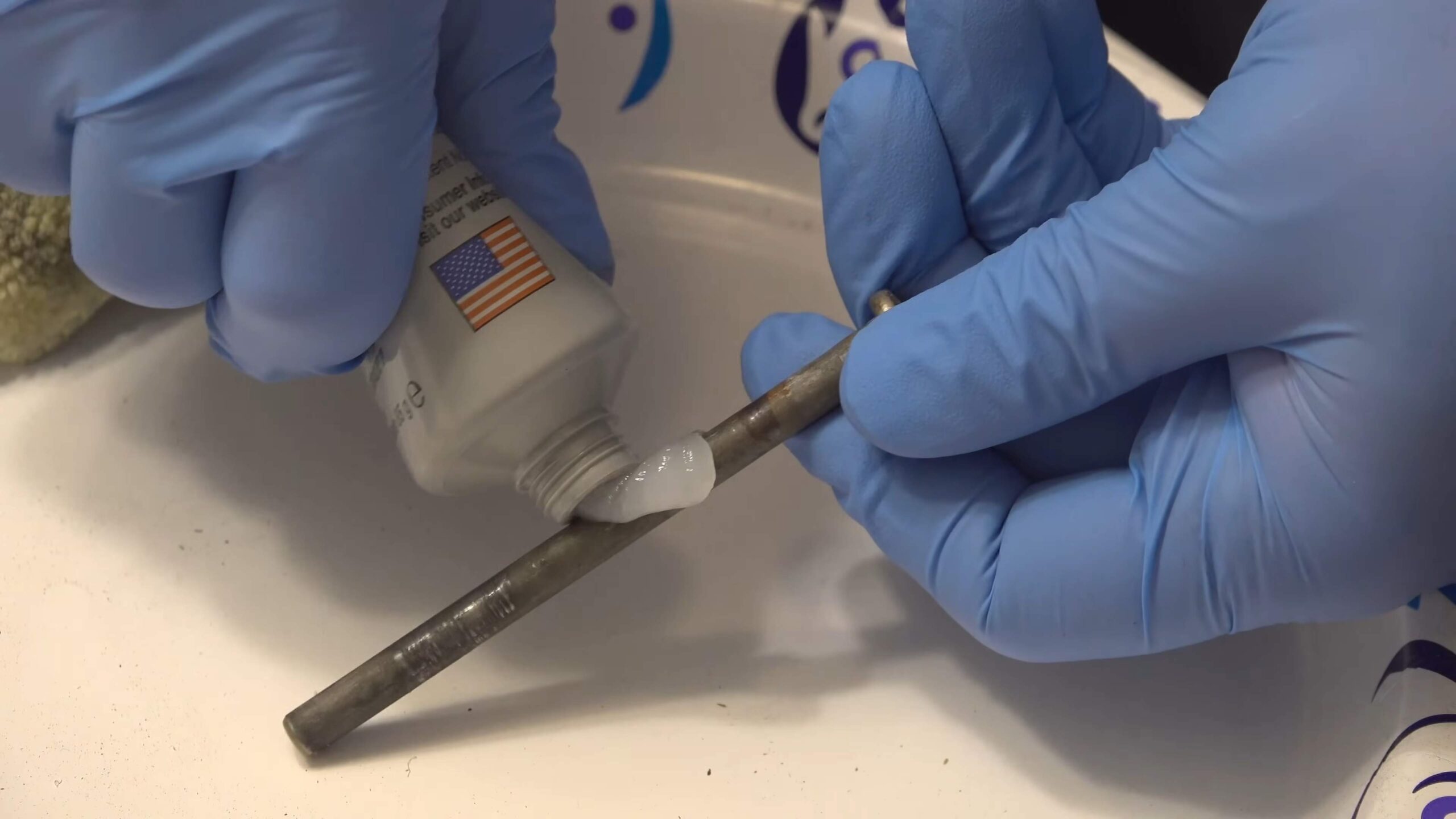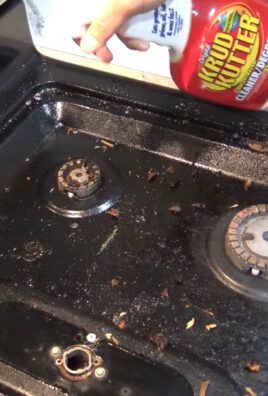Fix Squeaky Doors Easily with these simple DIY tricks! Is there anything more annoying than a door that announces your every move with a high-pitched squeal? I know I’ve been there, tiptoeing around trying to avoid waking the baby (or my grumpy partner!). But fear not, because you don’t need to be a handyman or spend a fortune to silence those noisy hinges.
Believe it or not, the problem of squeaky doors has plagued homeowners for centuries. While we might have fancy lubricants now, our ancestors relied on everything from animal fat to graphite to quiet their creaky entrances. Think about it – a quiet door was essential for privacy, security, and even just a peaceful night’s sleep! Today, while the stakes might not be quite so high, a squeaky door is still a major annoyance.
That’s why I’m so excited to share these easy and effective DIY solutions with you. You’ll learn how to fix squeaky doors easily using common household items, saving you time, money, and a whole lot of frustration. No more embarrassing entrances or waking up the entire house! Let’s get started and banish those squeaks for good!

Silence the Squeak: A DIY Guide to Fixing Annoying Doors
Okay, let’s face it, that squeaky door is driving you nuts, right? Every time someone opens or closes it, it’s like nails on a chalkboard. Well, fear not! I’m going to walk you through a super easy DIY fix that will have your doors swinging silently in no time. You don’t need to be a master carpenter or have a fancy toolbox. Just a few common household items and a little bit of elbow grease, and you’ll be enjoying the sweet sound of silence.
What You’ll Need
Before we dive in, let’s gather our supplies. Here’s what you’ll need to banish that squeak:
* **Lubricant:** This is the key! I recommend a silicone-based lubricant or a dry lubricant like graphite powder. WD-40 *can* work in a pinch, but it’s not a long-term solution as it can attract dust and grime. A dedicated lubricant is your best bet.
* **A small brush or applicator:** A small paintbrush, cotton swab, or even a clean rag will help you apply the lubricant precisely.
* **Hammer (optional):** You might need this if the hinge pins are stuck.
* **Nail and punch (optional):** Again, for stubborn hinge pins.
* **Paper towels or rags:** For wiping up any excess lubricant.
* **Safety glasses:** Always a good idea to protect your eyes.
* **A helper (optional, but recommended):** Having someone to hold the door steady can make things much easier, especially if it’s a heavy door.
Identifying the Culprit: Finding the Squeaky Hinge
Sometimes, it’s not immediately obvious which hinge is the source of the squeak. Here’s how to pinpoint the offender:
* **Open and close the door slowly:** Listen carefully to try and isolate which hinge is making the noise.
* **Apply slight pressure to each hinge:** While someone else opens and closes the door, gently press on each hinge one at a time. If pressing on a particular hinge makes the squeak disappear or change, you’ve found your culprit!
* **Visual inspection:** Look closely at each hinge. Are there signs of rust, dirt, or wear? This can also help you identify the problem hinge.
The Fix: Lubricating the Hinges
Now for the main event! We’re going to lubricate those hinges and silence that squeak.
1. **Prepare the area:** Place a paper towel or rag underneath the hinge you’re working on to catch any drips. This will prevent staining your floor or carpet.
2. **Apply the lubricant:** This is where your chosen lubricant comes into play.
* **For spray lubricants (silicone-based):** Insert the straw applicator into the nozzle. Aim the straw directly at the top of the hinge, where the pin enters. Give it a short burst of lubricant. Don’t overdo it! A little goes a long way. Work the door back and forth a few times to distribute the lubricant. Repeat this process for the bottom of the hinge and the middle (if accessible).
* **For dry lubricants (graphite powder):** Use a small brush or cotton swab to apply the graphite powder to the top and bottom of the hinge pin. Again, work the door back and forth to distribute the lubricant. Be careful with graphite powder, as it can be messy.
3. **Work the door:** Open and close the door several times, slowly and deliberately. This will help the lubricant penetrate the hinge and reach all the friction points.
4. **Wipe away excess lubricant:** Use a clean paper towel or rag to wipe away any excess lubricant that drips out of the hinge. This will prevent it from attracting dust and grime.
5. **Listen and repeat:** Listen carefully to see if the squeak is gone. If not, repeat steps 2-4. You may need to apply the lubricant a few times to completely eliminate the squeak.
6. **Address other hinges (if necessary):** If the squeak persists, even after lubricating the most likely culprit, repeat the process for the other hinges on the door. Sometimes, multiple hinges contribute to the noise.
Dealing with Stubborn Hinges: Removing the Hinge Pin
Sometimes, lubrication alone isn’t enough. If the hinge pin is rusty or corroded, it might be preventing the lubricant from reaching the friction points. In this case, you’ll need to remove the hinge pin.
1. **Support the door:** This is crucial! You don’t want the door to fall on you. Have a helper hold the door steady, or use shims or wedges under the door to support its weight.
2. **Tap the hinge pin:** Place a nail or punch against the bottom of the hinge pin. Gently tap the nail or punch with a hammer to drive the pin upwards. Be careful not to damage the hinge or the door frame. If the pin is really stuck, you might need to use a penetrating oil (like WD-40) and let it sit for a few minutes before trying again.
3. **Remove the hinge pin:** Once the pin is loose enough, you should be able to pull it out with your fingers or pliers.
4. **Clean the hinge pin:** Inspect the hinge pin for rust, dirt, or corrosion. Use a wire brush or steel wool to clean the pin thoroughly. You can also soak the pin in a rust remover if necessary.
5. **Lubricate the hinge pin:** Apply a generous amount of lubricant to the hinge pin before reinserting it.
6. **Reinsert the hinge pin:** Carefully reinsert the hinge pin into the hinge. You may need to tap it gently with a hammer to get it all the way in.
7. **Test the door:** Open and close the door to see if the squeak is gone. If not, you may need to repeat the process or consider replacing the hinge altogether.
Preventative Maintenance: Keeping Your Doors Squeak-Free
Once you’ve silenced the squeak, you’ll want to keep it that way! Here are a few tips for preventative maintenance:
* **Regular lubrication:** Lubricate your door hinges every few months, or whenever you start to hear a squeak.
* **Clean the hinges:** Periodically clean the hinges with a damp cloth to remove any dirt or grime.
* **Check for loose screws:** Make sure the screws that hold the hinges to the door and the door frame are tight. Loose screws can cause the door to sag and put extra stress on the hinges.
* **Consider replacing old hinges:** If your hinges are old, rusty, or damaged, consider replacing them with new ones. This can be a relatively inexpensive and easy way to improve the performance of your doors.
When to Call a Professional
While this DIY fix works for most squeaky doors, there are some situations where you might need to call a professional:
* **Damaged hinges:** If the hinges are severely damaged or broken, they may need to be replaced by a carpenter.
* **Door frame issues:** If the door frame is warped or damaged, it can cause the door to bind and squeak. This may require more extensive repairs.
* **You’re not comfortable doing the work yourself:** If you’re not comfortable working with tools or you’re worried about damaging your door, it’s always best to call a professional.
And that’s it! With a little bit of effort, you can easily silence that squeaky door and enjoy the peace and quiet of your home. Happy fixing!

Conclusion
So, there you have it! Banishing those irritating squeaks from your doors doesn’t require a toolbox full of specialized equipment or a call to a handyman. This simple, effective DIY trick to fix squeaky doors easily is a game-changer for anyone seeking a little peace and quiet in their home. We’ve shown you how readily available household items can be your secret weapon against noisy hinges.
Why is this a must-try? Because it’s quick, cost-effective, and incredibly satisfying. Imagine the relief of gliding through your home without announcing your presence with every creak and groan. Think of the improved ambiance, the uninterrupted conversations, and the overall sense of calm that a squeak-free environment brings. This isn’t just about fixing a door; it’s about enhancing your living space and reclaiming your peace of mind.
Beyond the basic method we’ve outlined, there are a few variations you might want to explore. For instance, if you’re dealing with particularly stubborn squeaks, consider using a lubricant specifically designed for hinges, such as white lithium grease or a silicone-based spray. These options offer longer-lasting lubrication and are especially effective for exterior doors exposed to the elements. Another variation involves using a small brush to apply the lubricant directly to the hinge pin, ensuring thorough coverage. If you don’t have a brush, a cotton swab will also work. Remember to wipe away any excess lubricant to prevent it from attracting dust and grime.
For a more natural approach, you can try using beeswax. Simply rub a small amount of beeswax onto the hinge pin and work it in by opening and closing the door several times. Beeswax provides a dry lubrication that won’t attract as much dirt as oil-based lubricants.
We understand that every door and every squeak is unique. That’s why we encourage you to experiment and find the method that works best for you. Don’t be afraid to try different lubricants or application techniques until you achieve the desired result. The key is to be patient and persistent.
But the real magic happens when you share your experiences. We want to hear your success stories, your challenges, and your creative solutions. Did you discover a particularly effective lubricant? Did you encounter any unexpected hurdles? Your insights can help others conquer their own squeaky door dilemmas.
So, go ahead, give this DIY trick a try. Silence those squeaks, reclaim your peace, and then come back and tell us all about it. Share your photos, your tips, and your triumphs in the comments below. Let’s create a community of squeak-free homes, one door at a time! We are confident that you will find this method to fix squeaky doors easily.
Frequently Asked Questions (FAQ)
What causes doors to squeak in the first place?
The primary culprit behind squeaky doors is friction. Over time, the lubricant in the hinges dries out or becomes contaminated with dust and grime. This lack of lubrication causes the metal surfaces of the hinge to rub against each other, producing that annoying squeaking sound. Other factors can contribute to squeaking, such as loose screws, misaligned hinges, or even changes in humidity that cause the wood to expand and contract.
What kind of lubricant should I use to fix a squeaky door?
There are several options for lubricating door hinges. A light household oil, such as WD-40 (used sparingly), is a common choice for a quick fix. However, it tends to evaporate relatively quickly, so you may need to reapply it periodically. For longer-lasting lubrication, consider using a heavier lubricant like white lithium grease or a silicone-based spray. These options are more resistant to drying out and can provide months of squeak-free operation. Another option is to use powdered graphite, which is a dry lubricant that won’t attract dust and grime.
How do I apply the lubricant to the hinges?
The best way to apply lubricant is to use the straw attachment that comes with most spray lubricants. This allows you to direct the lubricant precisely into the hinge pin area. If you’re using a liquid lubricant, you can use a small brush or cotton swab to apply it. Start by spraying or applying the lubricant to the top hinge, then open and close the door several times to work the lubricant into the hinge. Repeat this process for the other hinges. Be sure to wipe away any excess lubricant to prevent it from dripping or attracting dust.
What if lubricating the hinges doesn’t solve the problem?
If lubricating the hinges doesn’t eliminate the squeak, there may be other issues at play. Check the hinge screws to make sure they are tight. Loose screws can cause the hinge to shift and create friction. If the screws are stripped, you may need to replace them with longer screws or use wood glue to fill the holes before re-screwing. Another possibility is that the hinges are misaligned. You can try loosening the screws and adjusting the position of the hinges to see if that helps. If the door is rubbing against the frame, you may need to sand down the edge of the door or adjust the strike plate.
How often should I lubricate my door hinges?
The frequency of lubrication depends on several factors, including the type of lubricant you use, the climate you live in, and how often the door is used. As a general rule, it’s a good idea to lubricate your door hinges at least once or twice a year. If you live in a dry climate or the door is used frequently, you may need to lubricate it more often. Pay attention to any signs of squeaking and lubricate the hinges as needed.
Can I use cooking oil to lubricate door hinges?
While cooking oil might seem like a convenient option, it’s generally not recommended for lubricating door hinges. Cooking oil can attract dust and grime, which can actually worsen the squeaking problem over time. Additionally, cooking oil can become sticky and gummy as it ages, making it even more difficult to open and close the door. It’s best to stick with lubricants specifically designed for hinges.
Is it possible to over-lubricate door hinges?
Yes, it is possible to over-lubricate door hinges. Applying too much lubricant can cause it to drip and make a mess. It can also attract dust and grime, which can eventually clog the hinges. When lubricating your door hinges, use a light touch and wipe away any excess lubricant.
What if the squeak is coming from the door latch or strike plate?
Sometimes, the squeak isn’t coming from the hinges at all, but from the door latch rubbing against the strike plate. To fix this, try applying a small amount of lubricant to the latch and strike plate. You can also try adjusting the strike plate to ensure that the latch is engaging smoothly. If the strike plate is loose, tighten the screws or replace them with longer screws.
How can I prevent my doors from squeaking in the future?
The best way to prevent squeaky doors is to regularly lubricate the hinges. This will keep the hinges moving smoothly and prevent friction from building up. You should also inspect the hinges periodically to make sure the screws are tight and the hinges are properly aligned. By taking these simple steps, you can keep your doors squeak-free for years to come. Remember, a little preventative maintenance can go a long way in keeping your home quiet and comfortable. This simple guide will help you fix squeaky doors easily and keep them that way.





Leave a Comment